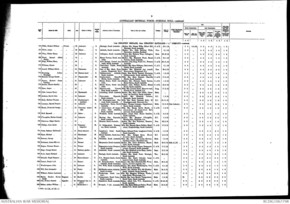WILLIAMS, Ernest
| Service Number: | 770 |
|---|---|
| Enlisted: | Not yet discovered |
| Last Rank: | Private |
| Last Unit: | 43rd Infantry Battalion |
| Born: | Woodville, South Australia, 1892 |
| Home Town: | Woodville, Charles Sturt, South Australia |
| Schooling: | Not yet discovered |
| Occupation: | Labourer |
| Memorials: |
World War 1 Service
| 9 Jun 1916: | Involvement Private, 770, 43rd Infantry Battalion, --- :embarkation_roll: roll_number: '18' embarkation_place: Adelaide embarkation_ship: HMAT Afric embarkation_ship_number: A19 public_note: '' | |
|---|---|---|
| 9 Jun 1916: | Embarked Private, 770, 43rd Infantry Battalion, HMAT Afric, Adelaide |
Help us honour Ernest Williams's service by contributing information, stories, and images so that they can be preserved for future generations.
Add my storyBiography contributed by Le Fevre High School
Ernest Williams was a South Australian man, who was born and raised in Woodville. His address was Chad Street, Yatala, South Australia. Before Ernest Williams had joined the war, his occupation was a labourer. He was not married, nor was he in a relationship. Ernest Williams was born in the year 1892 and his religion was Church of Christ. His mother’s name was Mrs Rose Williams, and her address was the same as Ernest’s as they had lived together until he had joined the war. His mother was also his Next Of Kin for Ernest when he went to enlist in World War 1.
Ernest Williams had enlisted in the war on the 05 January 1916 and his service number was 770. He was 24 years old when he had enlisted in the war. Ernest Williams had signed the war documents in Adelaide, South Australia. The unit that he was placed in was the 43rd Infantry Battalion, 3rd Division. Ernest Williams had embarked from Adelaide CBD, on the 09 June 1916 with his fellow soldiers and he had embarked on the ship called HMAT Afric A19. The medals that he won from fighting in the war were the British War Medal as well as the Victory Medal.
In World War One, Ernest’s rank was a private. A private is the lowest rank that you can get in the war. The job for a Private is they must do whatever they are obliged to do, which is told by their commanders. This would include anything from cooking food to fighting in the war. When the soldiers started to train in Australia, they trained in the sand hills between Glenelg and Henley for when they had firearm practice. A practice attack against the Hindmarsh Bridge was launched from Montefiore Hill.
On the 9th June 1916, the 43rd battalion had left Australia, they then briefly stopped in Egypt where they trained further. By July 1916, they had arrived in the United Kingdom, England, in Salisbury Plain for even more training. When December 1916 arrived, they moved to the Western Front in France. In the first half of 1917, it had engaged in trench warfare. The 3rd Division 43rd Infantry Battalion's major action as a formed whole was at Messines on the date 7th June 1917, shortly after the 43rd Battalion fought in the Third Ypres campaign. In 1918, the Battalion had later fought the Villers-Bretonneux, on the 4th July at Le Hamel and the ‘Last Hundred Days’ campaign. This Battalion was later awarded many Battle honours. Just to name a few would be Messines, Ypres, Somme, Poelcappelle and Ancre.
Once the war had ended in 1918, Ernest Williams had returned to Australia on the 12 May 1919, on a Monday. Much like other soldiers, he most likely kept to himself for a while and did not speak of the 2 years where he had fought not only for his life but for his country as well with many other soldiers. Many of the soldiers suffered from post-traumatic stress disorder (a disorder that can be described by failure to recover after experiencing or witnessing a terrifying event, in the soldiers’ case, all the fighting and death that occurred in the battlefield.) After the war, unfortunately there was no more information that was recorded for Ernest Williams. Even though that time has passed and people have gone on with life, the Anzacs will never be forgotten.











